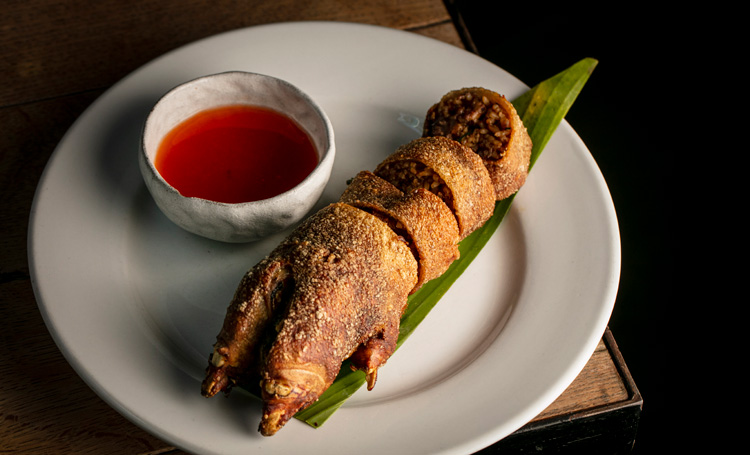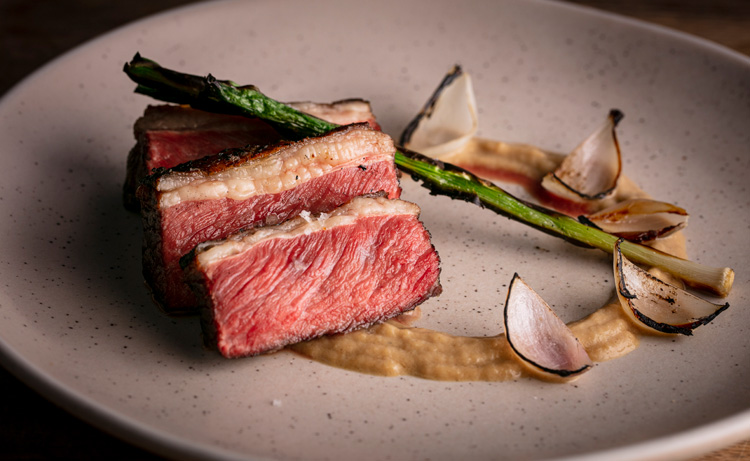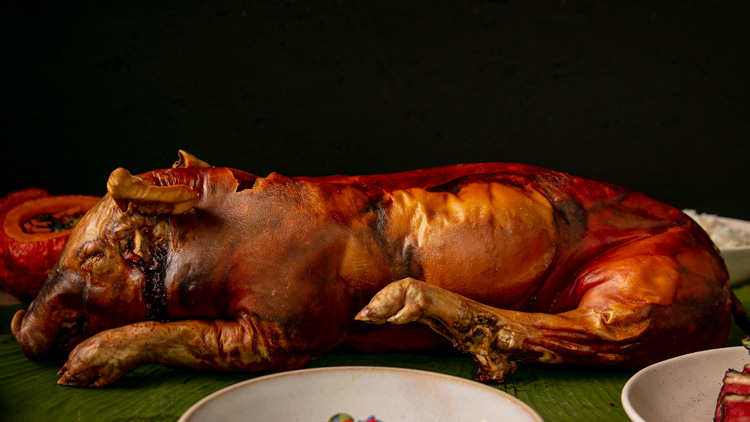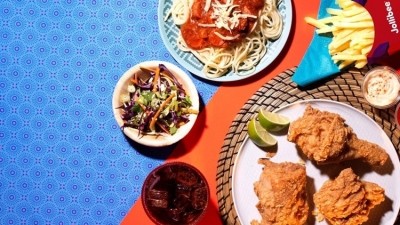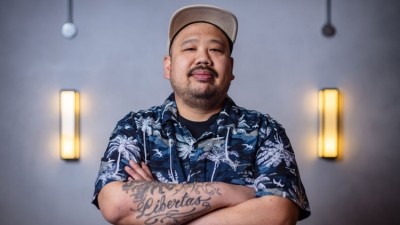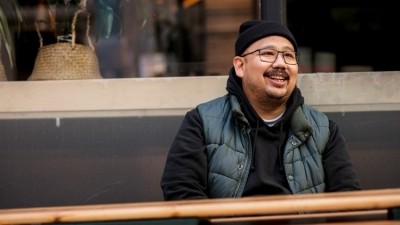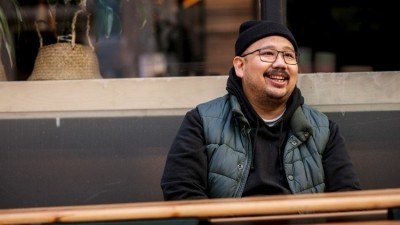Generation Next
That’s Sarap: meet the chef who believes London is ready for fine dining Filipino style
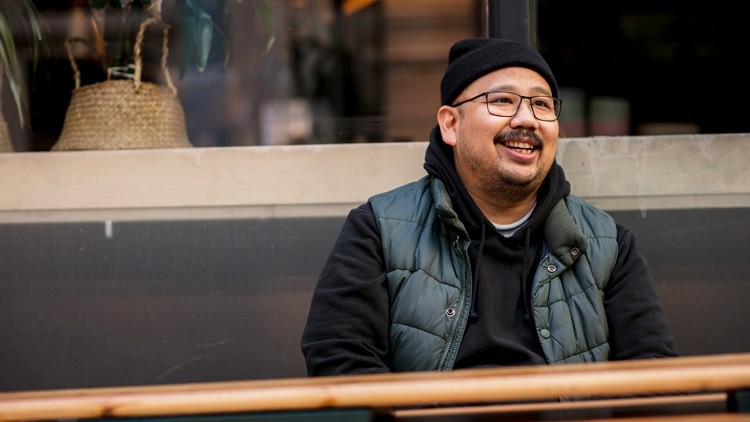
“I’ll be with you in a minute,” says Ferdinand ‘Budgie’ Montoya, quickly looking up from the tray of pig trotters he’s in the middle of prepping before immediately returning to the task in hand. Carefully, using the tip of his knife, he cuts down the bone of a trotter, easing it away from the adjoining skin and meat, until eventually it’s released. It’s a timely process, without doubt, but one that Montoya appears to have got down to a fine art.
The trotters will be used for rellenong crispy pata, one of the signature dishes at Montoya’s newly opened Sarap Filipino Bistro, which has taken up residency at rotating pop-up restaurant 10 Heddon Street in London’s Mayfair. After being deboned, the trotters are braised in an adobo stock of soy, cane vinegar, garlic, pepper and bay. The meat is then picked away from the skin and returned to the stock with rice, before being stuffed into the now hollowed-out trotter, rolled, and left to set overnight. They are then deep fried to order the following day, served with a fermented chilli and coconut vinegar sawsawan dip.
“It’s a long preparation process, but it’s such a striking dish,” says the chef restaurateur when he finally emerges from the kitchen. “Traditionally in the Philippines, the crispy pata is made using pork knuckle that’s boiled in aromatics, air-dried and deep fried. But I always said I wanted to make it with the trotter. We talk about zero waste as a marketing thing, but in the Philippines it’s a way of life, and drilled down from when I was a young child. Trotters are often overlooked as an ingredient, and we wanted to champion it.”
Sarap’s ‘latest evolution’
Sarap Filipino Bistro is described as 'the latest evolution' of Montoya’s Sarap brand, which he first established as a supper club back in 2017. While he was born in the Philippines, Montoya grew up in Sydney, Australia, before eventually moving to London to become a chef. His CV includes stints as a demi chef de partie at Tom Sellers’ Restaurant Story; sous chef at Soho House; and head chef at modern Asian restaurant Foley’s in Fitzrovia.
The genesis of the Sarap concept came at time when Montoya found himself craving the food of his homeland. “It started off with me asking my mum for recipes, and then recreating them at home. At the beginning I was really trying to chef it up a bit too much, which reflected my own lack of confidence in the cuisine. I’ve spent a lot of time learning to understand the flavour profiles, and how to capture that through my own cooking style.”
Montoya was initially approached to take up residency at 10 Heddon Street back when the pop-up space was first gearing up to launch in early 2019, but it wasn’t the right fit at the time. Having operated residencies at The Duke’s Head in Highgate and The Sun & 13 Cantons in Soho, he had recently triumphed in the ‘experienced’ category of the Brixton Kitchen competition, securing a six-month residency for Sarap on Market Row in Brixton Village, which eventually opened in January 2020.
“It wasn’t exactly perfect timing,” says Montoya, as he recalls having to shut down the restaurant when the first Coronavirus lockdown hit mere weeks after launching. “But it gave me time to properly work out what I wanted to do with Brixton site, and think about where else I wanted to take Sarap as a brand.”
Having managed to secure the Brixton site on a permanent basis in, Montoya relaunched the it late last year as Sarap BAon, which takes its cue from the Filipino mega mall food courts and serves a fast-casual menu of street food dishes including lechon, rolled and roasted pig’s belly; and fried chicken sinigang. “I’d always wanted to offer my own elevated take on Filipino cuisine, but Brixton just didn’t have the space or capacity to properly explore that. Having Sarap BAon there, though, has now given me the opportunity to do something away from it that’s more refined with Sarap Bistro.
“As unfortunate as the pandemic was, there was a lot of opportunity that came out of it. And chief among that it was creating two very distinct brands.”
Montoya’s arrival at Heddon Street reflects a clear move into the mainstream for the Sarap brand, but for the chef it means something more personal. “The mission, no matter where the location, is about bringing Filipino food forward, championing the cuisine and flavours, but doing it our way.
“We’ve never said we were authentic. I’m Filipino born but grew up in Sydney and live in London. The food at Sarap Bistro is very authentic to me, and I think we capture the flavours very well and we want to be faithful in that regard, but not restrained by regurgitating classic dishes. We want to be creative and put our stamp on things.”
A growing space
Sarap, which translates as ‘delicious’, is one of a number of Filipino brands currently making moves in the capital. In nearby Soho, the team behind Kensington’s Romulo Café has just launched Kasa and Kin, which offers a more contemporary spin on the country’s cuisine. Meanwhile, in KERB’s Seven Dials Market, the founders of BBQ Dreamz – the street food trader which appeared on the BBC's My Million Pound Menu – operate Bong Bong’s Manila Kanteen, which specialises in crispy pata pork hocks.
And then there’s Jollibee, the Filipino fast-food chain that serves an Americanised menu primarily focused on fried chicken. Having opened its first UK restaurant in London’s Earl’s Court back in 2018, it is now aiming to have at least 50 sites across the UK by 2025. The chain was founded in the Philippines back in 1978, and currently operates close to 1,500 locations worldwide.
Montoya is heartened by the growing activity in the space. “What’s great about all of us is while we’re all championing Filipino cuisine, we’re all doing something different,” he says, enthusiastically. “Competition is great. It drives innovation and encourages us as a business to maintain a high level of quality and make sure we can stand up to them.”
A challenge that Montoya notes for Filipino brands in the capital is that the country’s food doesn’t yet have the profile of other, more recognisable Asian cuisines like Chinese or Thai. “One of the things we particularly struggle with is preconception. People try to compare Filipino food with other prominent Asian cuisines. Its scope is much greater, though, and what makes it difficult is that you don’t currently have enough people promoting it. There’s a lot of Filipino chefs in London, but they’re not cooking Filipino food.”
Filipino cuisine can fairly be defined as a melting pot of western and eastern influences that begins with the pre-Hispanic era and includes Chinese traders, Indo-Malay visitors, Spanish colonisers and American exports. With that in mind, I ask Montoya if another reason the cuisine is more of a tough sell in the capital is because it lacks identity?
“Definitely,” he responds, after a pause. “But while it doesn’t have a clear identity, there are clear similarities with other cuisines. Because of our history, there’s a familiarity with how dishes reference other places, and that surprises people. It makes the food more approachable, which is crucial when we’re trying to enlighten people about it.”
A chef-led approach
While Sarap BAon, with its quick-service model and street food menu, offers a more accessible entry point into Filipino cuisine, Sarap Bistro reflects Montoya’s own singular and personal interpretation of it. “I see the Bistro as being Sarap’s flagship concept, where you’ll find me in the kitchen most nights. I want it to show a more delicate, chef-led approach to Filipino cooking.”
The Sarap Bistro sharing menu is short – reflective of the size of the 10 Heddon Street kitchen – with three small plates and four larger dishes available. Alongside the crispy pata pig’s trotter, the small plates include ensaladang talong - smoked aubergine served with winter tomatoes and salted duck egg; and a market fish kinilaw of coconut vinegar-cured market fish with calamansi gel and cucumber.
Larger plates include roasted celeriac served with a peanut and achuete sauce and topped with truffle; aged rump cap with a calamansi and soy jus, grilled leek, pickled shallots and yeasted onion; and spatchcocked poussin marinated in lemongrass, calamansi, and coconut vinegar, and cooked over charcoal. As well as jasmine rice, the sides include kale that’s been slow braised in coconut milk, ginger, garlic and chilli; and charred hispi cabbage with fermented shrimp butter, crispy shallots and spring onions. Prices are perhaps higher than expected, but competitive with the Mayfair market, with smaller plates ranging from £8.50 to £13; and the larger plates between £18 and £25.
“We’re pushing the boat as to what can be defined as Filipino cuisine, and I’m comfortable with that,” says Montoya. “It’s about creating a different identity to Brixton and cut through the noise of the London dining scene.”
One dish that underpins the differences between Sarap BAon and Sarap Bistro is the lechon. In Brixton, it is available to order in portions of either 150g, 300g or 600g, on its own or with rice and atchara (pickled papaya), with prices starting at £8.50. At Heddon Street, the lechon is only available as a whole, slow-roasted suckling pig stuffed with lemongrass and truffled adobo pork rice. Meant for six to eight people, it costs £295 and must be ordered at least 48 hours in advance.
“We wanted to serve lechon here, but we didn’t want it to be the same as it would be found in Brixton. Lechon in the Philippines is a celebratory dish, and we wanted to capture that sense of festivity. It’s a dish that creates conversation, and it’s so impactful.”
Future ambitions
The Heddon Street residency will last for up to a year and is intended to be used by Montoya as a launch pad to establish a permanent central London site for the Filipino Bistro concept, in partnership with The Pepper Collective. “You have to be looking at wanting to go into bricks and mortar. It can’t just be treated it as a pop up.
“Yes, it’s a testing ground, but it’s not simply about seeing how we do over six or eight months. We’re approaching it as if Heddon Street was our permanent home.”
Montoya has no plans to grow the Bistro brand into a scalable concept but does hope to eventually establish a collection of Sarap BAon sites. “It’s a concept that can be replicated and is easier to gravitate to,” he explains. “I could certainly see it expanding into street food settings, market stalls and small footprint sites further down the line.”
For now, though, as well as honing the Sarap Bistro concept, Montoya’s main focus is expanding his own repertoire and understanding of Filipino cuisine. “I haven’t been to the Philippines for a long time, and there’s so many dishes I’m unaware of. The cuisine in the south is markedly different, but there’s not a lot of literature about it. I really want to explore and learn more about that.
“At the moment it’s about making small, incremental improvements to the dishes we’re already serving. In time, though, regionality is what I’m keen to learn and really bring to the fold.”
